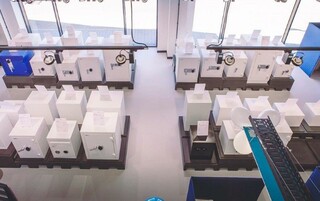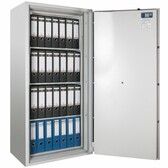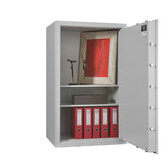Security is one of the key aspects of every area of our lives. We want to feel safe and we want to make sure that the values we own are also adequately protected. When we think about protecting values, safes are the most important tool for securing them and protecting them from unauthorised access and theft. In this article, we will look at the different security classes of safes, their features and indicate why choosing an adequate security class is so important when it comes to securing your valuables.
Burglary resistance classes for safes
What do the resistance classes of safes actually mean? Burglary resistance classes for safes are certain standards which define the level of security, in other words – the resistance which a safe is able to provide against attempted break-ins. These classes, usually denoted by letters and numbers, allow safes to be compared in terms of their ability to repel attacks. The higher the security class a safe has, the more time-consuming and complicated it is to get to the deposit. The higher the security class of the safe, the higher the level of protection and the safer the deposit is.
How can you recognise the security class of a safe? Every safe is marked with the relevant security class – a rating plate with the security class stamped on it is located on the inside of the door.
The security level of safes in accordance with the European standard EN 14450
This standard applies to safes with security levels S1 and S2. Safes with security levels S1 and S2 guarantee a basic protection against burglary. Why is this so? It is primarily a question of how these safes are made.
• safes in security level S1 according to EN 14450 have a single-walled body made of 3 mm thick sheet metal and double-walled doors;
• safes in class S2 according to EN 14450 are constructed with a double-walled body and a double-walled door.
Despite the fact that these products provide only primary burglary protection, it is permissible to store weapons in a safe of at least Class S1 according to the 26. August 2014 regulation of the Minister of the Interior. However, in a situation where security is a key issue, it is worth considering the purchase of a more specific safe – a higher resistance class is definitely a better security.
Security level of safes in accordance with the European standard EN 1143-1
Safes complying with this standard are characterised by their specific design (in terms of construction) and thus by the much longer time it takes to break through these defences. In practice, safes up to class V are most common. Higher resistance classes (from VI upwards) are used for safes and vaults – i.e. products for special tasks.
Safes in classes 0-V according to EN 1143-1 have a multi-walled door and a multi-walled body (sheet metal coats). The different degrees of burglary resistance are achieved through the filling material used (including mixtures of concrete and reinforced mats), the amount of this material and the thickness of the walls. In addition, safes of class IV and above must be fitted with a combination of two locks. In lower classes, one type of lock is generally fitted (this can be a key lock with 2 keys included, an electronic lock, an electronic lock with a revision function, i.e. the possibility of emergency opening with a key, a combination lock or a biometric lock).
Anti-theft capability of safes in practice: how long it takes to get into the safe (RU resistance unit)
How does a safe obtain a specific burglary resistance certificate? When safes are classified, they are subjected to examinations and tests (attempts to forcibly open them and get inside) carried out in testing laboratories. The time required for a burglary (partial or total) using a tool or tools is expressed by the RU index (resistance unit). The higher the number of RU units, the higher the burglary resistance of the safe and therefore the higher the security level.
Below you will find information on the security level of safes (RU indicator) for the individual security classes of safes (successively for partial and total access to the contents of a specific certified device):
• S1 (according to EN 14450) – 10/10,
• S2 (in accordance with EN 14450) – 20/20.
As for the higher classes of burglary safes (according to EN 1143-1):
• 0 – 30/30,
• I – 30/50,
• II – 50/80,
• III – 80/120,
• IV – 120/180,
• V – 180/270.
Knowing that time is the burglar's and thief's greatest 'enemy' – definitely the higher the class of the safe, the longer the values deposited in it will be secure.
Burglar-proof safes and deposit insurance
The resistance classes of safes determine what values can be stored in them. Many of our customers ask whether they can insure the values deposited in the safe. We recommend consulting your insurance agent on this matter – each insurance company sets its own requirements in terms of the expected security class of the safe. The amount of insurance also depends on the company in question.
In order to meet the security requirements, you should follow our recommendations for professional installation (anchoring) of the safe at the place of use.
Safety classes for safes and limits of stored values
The higher the security grade of a safe, the greater the values that can be deposited in it. The degree of resistance is assigned by independent institutions. Different tests are carried out using a variety of tools to determine how long a safe can withstand burglary attempts. Once the safe has passed the tests, it is then certified in the appropriate resistance class.
Choosing the right security class is important for the protection of the safe's contents, but also for the issue of possible deposit insurance.
If you are an entrepreneur, you may be interested in the permissible limits of stored values in each class in accordance with the decree of the Ministry of Internal Affairs and Administration of 7th September 2010 on requirements which should be met by protection of monetary values stored and transported by entrepreneurs and other organisational units (Journal of Laws of 9.09.2010) and the value of insurance of a safe in a given security class. The limits change quarterly, as they are linked to the calculation unit, and the calculation unit determines the value of the limit amounting to 120 times the average gross monthly remuneration for the previous quarter, announced by the President of the Central Statistical Office in the Official Journal of the Republic of Poland 'Monitor Polski'. According to the data, the average salary in the fourth quarter of 2023 was PLN 7540.36.
The value storage limits are as follows (for units not equipped with an intrusion signalling system):
• S1: 0.1 units of account – PLN 90,484.32,
• S2: 0.2 units of account – PLN 180,968.64,
• 0: 0.5 units of account – PLN 452,421.60,
• I: 1.0 unit of account – PLN 904,843.20,
• II: 1.5 units of account – PLN 1,357,264.80,
• III: 3 calculation units – PLN 2,714,529.60,
• IV: 5 units of account – PLN 4,524,216.00,
• V: 8 calculation units – PLN 7,238,745.60.
Features of safes and security classes
Burglary resistance classes are one of the criteria we should look at when choosing the appropriate model. There are a number of additional features that affect the convenient use of a safe. These include:
• the mounting location: the more often you use the safe, the better it is to have it always at hand and easily accessible. It is a good idea to mount small safes at a certain height (e.g. in a domestic setting, small furniture safes can be placed on a shelf in a cupboard and attached to the back wall). Mounting a small safe directly on the floor will make it necessary to bend down to access the deposit. It is worth remembering that a well-mounted safe, attached to the solid structure of the building, is much more difficult to remove.
• the size of the safe: we know from experience that it is best to buy a safe that is larger than it may appear at the moment. Over time, the value increases – not the other way around.
• advanced locks: safes can be fitted with modern locks (e.g. biometric fingerprint readers). Such solutions make access to the safe even more difficult.
• fire resistance: some safes are certified to be fireproof and can store valuables such as important documents or data carriers. Fire resistance is defined by the length of time (in minutes) that the safe is able to protect the contents from heat.
Choosing the right security class
How to choose a safe? The decision to choose an adequate security class for a safe should be carefully considered and the individual needs of the user must be taken into account. It is advisable to consult the advisors at HARTMANN TRESORE in order to find the optimum solution.
Remember also that the safe is one component of an overall security system. The combination of a safe, an alarm system and appropriate security procedures can effectively protect valuable items from a variety of threats.
The choice of a burglar-proof safe should be closely related to the individual needs of the user. People storing valuable jewellery, documents or other valuables in a safe should invest in one with a higher burglary protection class. However, companies or institutions that store large amounts of cash or documents may require safes with even higher security standards.
It is also worth consulting industry professionals or security specialists who can advise on the best safe to suit the specific premises and needs of a user.
Summary
Burglar safes are a key security measure for valuables – those of lesser and significant value, providing protection against unwanted access and theft. The classification of burglar safes includes different levels of security, and the choice depends on individual needs and the value of the items stored. The differences between classes reflect the differences in the level of protection they offer.
It is worth investing in an adequate resistance class; after all, a safe is a purchase for years to come.





